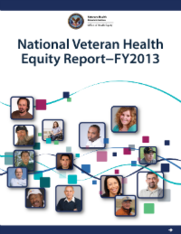 Washington, DC – October 4, 2016 – Today, the VA Office of Health Equity releases the first-ever National Veterans Health Equity Report. The report details patterns and provides comparative rates of health conditions for Veterans by race/ethnicity, gender, age, geography, and mental health status. Now with the release of this report, VA and Veteran stakeholders can monitor the care vulnerable Veterans receive and set goals for improving their care.
The current National Veteran Health Equity Report is based on Veterans in VHA care during fiscal year 2013 and covers the vulnerable populations for which data were available at that time. Each chapter describes in detail Veteran characteristics, patterns of health care use, and medical diagnoses for Veterans; and highlights implications of the findings for eliminating disparate health care. Data used to generate the report come from VHA administrative databases related to inpatient, outpatient, and community care. The report intends to improve access and aligns with the Health Equity Action Plan, which is VA’s strategic plan to achieve health equity for all Veterans.
The inaugural National Veterans Health Equity Report is another step the VA is taking to ensure that all eligible Veterans have access to the care they have earned and deserve, and such care is equitable. Following are highlights from the report:
- Most racial/ethnic minority groups, compared with White Veteran patients, had lower diagnosed condition rates. However, Native Hawaiian or other Pacific Islander and American Indian or Alaska Native Veteran patients, compared with White Veteran patients, had much greater use of fee services, and somewhat higher use of telephone and emergency department visits. Asian Veteran patients had lower use of several types of services compared with White Veterans. All racial/ethnic minority groups had greater use of mental health/substance use disorder services compared with Whites.
- Despite their younger average age, female Veterans have higher or similar rates of most diagnosed condition domains compared to male Veterans. However, mental Health and substance use disorder conditions affect nearly half of women Veteran VHA patients and are far more common in women than in men (46% vs 32%).
- Overall, the distribution of diagnosed conditions between rural and urban Veterans are largely similar, with rural Veterans having higher diagnosed rates of some conditions (e.g., diabetes and COPD) while urban Veterans have higher diagnosed rates of other conditions (e.g., HIV and Hepatitis C Virus).
- Lower rates of telephone visits, compared with encounter rates for other types of care, may reflect differences in older patients’ comfort with technology-driven care. Addressing gaps in the use of telephone visits is particularly important for older patients who, relative to their younger counterparts, are more likely to reside in rural areas and who may have other barriers to accessing face-to-face care (e.g., lack of transportation and physical frailty).
-
The Veteran population with serious mental illness (SMI) in VA care in FY13 is 4.6%, which is a rate that is slightly higher than the global rates of those living with these disorders. Similar to the overall VA population and every mental health group, the population with SMI in VA care in FY13 had high rates of hypertension and lipid disorders. Unique to the SMI population, there was also a very high rate of tobacco use disorder.
“Achieving health equity takes all hands on deck,” says Dr. Uchenna S. Uchendu, Office of Health Equity Chief Officer. “This foundational National Health Equity Report should be used to raise awareness and educate stakeholders so that we eliminate disparities some Veterans face. My staff and I will keep working with our partners to make sure everyone understands and owns their specific role in providing equitable access and care for the women and men who sacrificed for our freedoms without hesitation.”
The National Veteran Health Equity Report is available today by visiting http://www.va.gov/healthequity/NVHER.asp. Also, the VA Office of Health Equity is hosting a webinar on October 27, 2016 to highlight this new report and findings. The report aligns with the MyVA initiatives, the VHA effort to improve access to care for all Veterans, the VHA Health Equity Action Plan, the recent VA Commission on Care Report, and momentum across the country by adding to the body of knowledge about vulnerable Veteran populations.
VA Office of Health Equity champions health equity issues on behalf of Veterans in order to diminish and where possible eliminate health and healthcare disparities. Visit http://www.va.gov/healthequity to learn about Veteran health equity issues, access the report, and to sign up for the October 27, 2016 webinar.
|